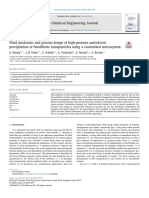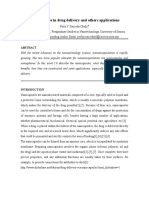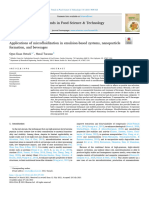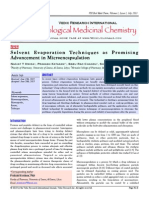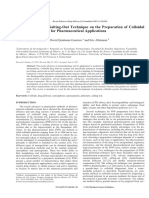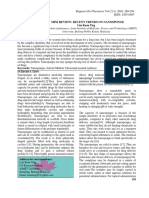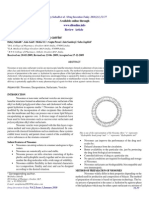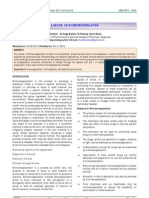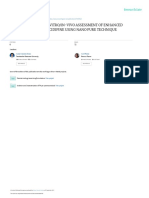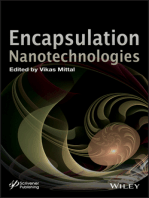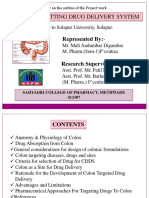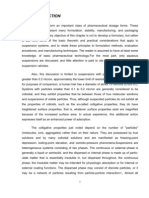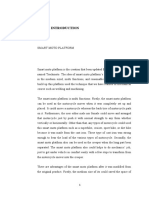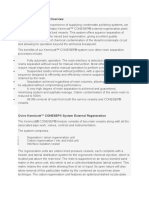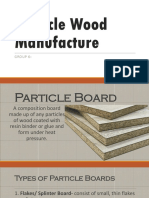Spray-Drying Technique To Prepare Innovative Nanoparticulated Formulations For Drug Administration: A Brief Overview
Spray-Drying Technique To Prepare Innovative Nanoparticulated Formulations For Drug Administration: A Brief Overview
Uploaded by
princeamitCopyright:
Available Formats
Spray-Drying Technique To Prepare Innovative Nanoparticulated Formulations For Drug Administration: A Brief Overview
Spray-Drying Technique To Prepare Innovative Nanoparticulated Formulations For Drug Administration: A Brief Overview
Uploaded by
princeamitOriginal Title
Copyright
Available Formats
Share this document
Did you find this document useful?
Is this content inappropriate?
Copyright:
Available Formats
Spray-Drying Technique To Prepare Innovative Nanoparticulated Formulations For Drug Administration: A Brief Overview
Spray-Drying Technique To Prepare Innovative Nanoparticulated Formulations For Drug Administration: A Brief Overview
Uploaded by
princeamitCopyright:
Available Formats
Brazilian Journal of Physics, vol. 39, no.
1A, April, 2009
205
Spray-drying technique to prepare innovative nanoparticulated formulations for drug administration: a brief overview
S.S. Guterres
Programa de P os-Graduac a encias Farmac euticas, o em Ci Faculdade de Farm acia, Universidade Federal do Rio Grande do Sul, Av Ipiranga, 2752, Porto Alegre, 90610-000, RS, Brazil
R. C. R. Beck
Departamento de Farm acia Industrial, Centro de Ci encias da Sa ude, Universidade Federal de Santa Maria, Av. Roraima, 1000, Santa Maria, 97105-900, RS, Brazil
A. R. Pohlmann
Departamento de Qu mica Org anica, Universidade Federal do Rio Grande do Sul, PBOX 15003, Porto Alegre, 91501-970, RS, Brazil (Received on 15 July, 2008) Polymeric nanoparticle systems (nanocapsules and nanospheres) present potential applications as drug delivery systems. Nevertheless, their full applications have not been exploited due to their limited shelf life when stored in aqueous medium. Drying polymeric nanoparticles using spray-drying represents a promising platform to improve the physicochemical stability of formulations and/or to control the release of hydrophilic and lipophilic drugs. This article presents a brief overview of the most recent and ongoing research in the use of spray-drying process to prepare and/or to dry polymeric nanoparticles formulations intended for drug administration.
Keywords: microparticles; nanocapsules; nanospheres; spray-drying
I.
INTRODUCTION
Spray-drying is a common technique used in pharmaceuticals to produce a dry powder from a liquid phase [1]. This technique has also been employed as a microencapsulation method because it can be adapted to the development of different systems, microspheres or microcapsules, depending on the initial aqueous formulation, a solution, a suspension or an emulsion [2]. Another application is its use as a preservation method, increasing the storage stability due to the water elimination. Nanoparticle, submicronic colloidal carriers, is a general name to describe nanocapsules and nanospheres. Nanocapsules correspond to a polymeric wall enveloping an oil core, while the nanospheres consist of a polymeric matrix [3]. Nanoparticles have been extensively studied over the last years in order to control the drug release, to increase the drug selectivity and effectiveness, to improve drug bioavailability and decrease the drug toxicity [4,5]. Nevertheless, the full applications of polymeric nanoparticles have not been exploited due to the lack of stability of formulations when conserved in aqueous medium for a long period [6]. During the storage, microbiological growth, polymer hydrolysis and physicochemical instability as a consequence of particle aggregation can take place [7]. According to Tewa-Tagne and co-workers, efforts to develop more stable nanoparticle formulations have been unsuccessfully carry out for many years [8]. The type and the concentration of surfactants in the formulations have been varied, but the results shown good stability only in the short-term [9,10]. On the other hand, the incorporation of nanoparticles in solid dosage forms resulted in phase separation after the addition of different polymeric binders to aque-
ous suspensions of nanoparticles [11]. So, the development of an effective technique to improve the shelf life of nanoparticles is a requirement. Microparticles are generally composed by polymeric materials and present advantages such as a rapid and one step production, ready distribution on a large surface of the body, more constant plasma levels, higher accuracy in reproducibility dose-by dose, less decrease in bioavailability and minor risk of toxicity due to the dose dumping [12,13]. A modern microparticle formulation should be able to provide a controlled and well-dened drug release pattern. In the last years our research group and others have been involved in the study of the potential of the spray drying technique to stabilize polymeric nanoparticle aqueous suspensions converting them into powders, as well as to prepare innovative nanocoated-microparticles to control the drug release. So, this article presents a brief overview of most recent and ongoing research in the use of spray-drying process to prepare and/or to dry polymeric nanoparticles formulations intended for drug administration.
II.
DRYING POLYMERIC NANOPARTICLE SUSPENSIONS
Electronic
address: silvia.guterres@ufrgs.br
Aiming to overcome the instability of nanocapsules, our group proposed for the rst time in 2000 the use of the spraydrying technique to convert nanocapsule or nanospheres aqueous formulations into powders [14]. So, we reported oral solid forms containing diclofenac-loaded nanoparticles, prepared using colloidal silicon dioxide (Aerosil R 200) as drying adjuvant (Figure 1A). The scanning electron microscopy analysis of spray-dried powders showed spherical microparticles, which presented the nanoparticles on their surface. The powders obtained from the nanocapsule suspensions showed nanostructures adsorbed on the microparticles, with similar
206 particle sizes (200 nm) than those determined by PCS in the suspensions before dehydration process [14].
S. S. Guterres et al. Indeed, based on those results we acquired the knowledge needed for the design of homogeneous nanocoating surfaces. The morphologic control of the micro-powder coating is determined by the use of either polymeric spheres or vesicular nanoparticles. These studies showed the different behavior of polymeric nanocapsules and nanospheres in the preparation of these organic-inorganic microparticles [15,16,19,23]. The nanosphere suspension (polymeric matrix) or the nanocapsule suspension (vesicular nanostructure) led to microparticles presenting different and homogeneous nanocoating after the drying process [16]. It is important to note that considering this drying strategy the drug is encapsulated in the polymeric nanoparticles. In spite the evident advantages of the spray-drying in the presence of silicon dioxide as a strategy to dry the aqueous suspensions, the interactions between the polymeric nanoparticles and the silicon dioxide had not been investigated. Viewing to understand what kind of interactions takes place, Tewa-Tagne and co-workers demonstrated that the interactions occurring in the feed are directed by hydrogen bounds and they were more sensitive to the silica concentration than that of nanocapsules [8]. SEM analyses of the powders showed spherical separated microparticles formed by the association of nanocapsules and silica when they are mixed at adequate concentrations in the feed before spraydrying. On the other hand, fused agglomerated particles presenting nanocapsules at their surface, characterized by irregular shapes and a strong adhesiveness were prepared when the silica concentration was not sufcient. More recently, the effects of formulations and spray-drying process variables on the powders properties has been studied in order to optimize the process [22]. Due to the high numbers of parameters involved in the spray-drying process, particular attention is required in the process optimization. Responses such as temperature, moisture content, operation yield, particle size and particle densities are useful to determine the optimal operational conditions. In the particular case of drying nanocapsules using silicon dioxide as an auxiliary agent, the concentrations of both determined the powder characteristics. Besides silicon dioxide, soluble supports such as lactose, PVP-K30 and mannitol can also be employed to dry nanocapsules [24]. Using nanocapsules at a concentration of 1% (w/v) and lactose at 10 % (w/v), the powder had adequate morphology and ease reconstitution in water (Figure 1B). Focusing on the size distribution after reconstitution, satisfactory result has been observed using mannitol and PVP-K30 both at 10 % (w/v).
Drug
Aerosil 200
Xerogel
Polymeric nanoparticles (matricial or vesicular)
FIG. 1: Illustrative representation of the architecture of different nanostructured microparticles obtained either by sequential assembly of silica and polymeric nanoparticles or by drying polymeric nanoparticles: type A is prepared by drying the drug-loaded polymeric nanoparticles with colloidal silicon dioxide; type B is obtained by drying the polymeric nanoparticles using water soluble materials; and type C and D are prepared by coating the drug-loaded Aerosil R 200 or xerogel, respectively, with polymeric nanoparticles
On the other hand, the micro-powders prepared from the nanosphere suspensions presented a reduction in the particle size which decreased from 200 nm to 60-90 nm after drying [15,16]. The polymeric nanoparticles used to coat the inorganic microparticles can be prepared by nanoprecipitation or interfacial deposition of pre-formed polymers [17], as well as by emulsication-diffusion technique [18]. Regarding the biological effects, after oral administration in rats, the diclofenac-loaded nanocapsule spray-dried powders dispersed in water were valuable for reducing the gastrointestinal irritant effect of the non-steroidal anti-inammatory drug [19]. In parallel, a pharmacokinetic study in rats was also conducted, showing a complete oral absorption of the drug from spray-dried powders dispersed in water [19]. In addition, those diclofenac-loaded nanoparticle spraydried powders have been investigated after 14 months of storage at ambient temperature. The powders showed higher chemical stability than the drug-loaded nanocapsule suspensions. Our study showed that besides the nature of the formulation, suspension or powder, the decrease in the drug content is dependent on the type and concentration of the surfactant system. An accelerate stability study carried out under UVC light exposition followed by mass spectrometry analysis demonstrated that 2-(2,6-dichlorophenyl)aminobenzyl alcohol and N-(2,6-dichlorophenyl)anthranilylaldehyde were the diclofenac degradation products [20]. Nanocapsules and nanospheres containing an antiinammatory drug were freeze-dried after addition of colloidal silicon dioxide to obtain intact dried nanoparticles [21]. The micro-powder surfaces presented a homogeneous nanocoating and satisfactory biological effect (gastrointestinal tolerance). However, in spite these promising results, the freeze-drying technique is highly expensive and reserved for products with high added value [22]. So, we continued our study in the use of spray-drying to dry the polymeric nanoparticle suspensions. In the case of the nanocapsule spray-dried powders, the oil concentration in the suspension presented an important inuence on the homogeneous recovering of the particles. The powders prepared using low oil concentration showed two patterns of nanoparticles on the microparticle surface [23].
III. PREPARING INNOVATIVE NANOPARTICLE-COATED MICROPARTICLES
As described above, we have developed a method to dry nanoparticulated aqueous suspensions by spray-drying in order to obtain dried nanoparticle formulations. Actually, the powders consisted of microparticles of silicon dioxide coated by polymeric nanoparticles (containing a drug) (Figure 1C). Besides the higher stability compared to the original nanoparticle suspension, these powders have the ability to control and sustained the drug release. Melatonin-loaded nanocapsule spray-dried powder improved the physical stability of the
Brazilian Journal of Physics, vol. 39, no. 1A, April, 2009 formulation and controlled the drug release prole in comparison with the pure drug [25]. Moreover, a monoexponential model described the release prole and the drug release was governed by swelling, relaxation and dissolution of the polymer. Indeed, coating techniques are largely employed in order to control the drug release from dosage forms for oral administration, as well as to protect the drug from inactivation or the gastrointestinal mucosa against drug damage. In general coating processes are carried out on single unit dosage forms, as tablets or capsules, after their production [26]. Several reports in the literature show that the coating of particles presents more advantages compared to the coating of unit dosage forms [27,28]. These advantages are given by the more reproducible gastrointestinal transport, higher bioavailability, more uniformly spread out in the gastrointestinal tract and reduction of the local irritation. The main useful methods in particle coating are air suspension (Wurster process, uidbed dryer), centrifugation, spray drying, coacervation (aqueous phase separation) and interfacial polymerization [26]. Taking into account that coating systems using organic solvents need to be avoided due to safety and economic disadvantages and that the polymeric nanoparticles are aqueous dispersions, we considered that the latter could be also useful to coat the microparticles to control the drug release. In this way, new nanoparticle-coated drug-loaded organic-inorganic microparticles using the spray-drying technique were proposed (Figure 1C). In 2004, we reported for the rst time the preparation of spray-dried nanoparticle-coated microparticles using diclofenac and unloaded nanoparticles (nanospheres or nanocapsules) prepared with Eudragit S100 R as a coating material [29]. The work showed the preparation of these microparticles using a one-step and a two-step method. In the one-step method the microparticles were prepared by the addition of the drug and silicon dioxide directly into the nanoparticle suspension before the spray-drying. On the other hand, using the two-step method, an organic-inorganic core was previously prepared by mixing the drug and silicon dioxide in acetone followed by solvent evaporation under reduced pressure. This core was redispersed in the nanoparticle suspension before the drying process. All formulations showed the presence of nanostructures on their surface forming a covering layer which particle diameters were in accordance with the original suspension. When the diclofenac (sodium salt) was employed as hydrophilic model, the powders prepared in two steps (core previously prepared) showed satisfactory gastroresistance. The use of diclofenac (acid form) as hydrophobic model also conducted to powders presenting good gastroresistance using triacetin as a plasticizer in the nanocapsule formulations [30]. The type of the coating layer (nanospheres or nanocapsules) had also an important inuence on the protective efciency against gastrointestinal injury after oral administration of diclofenac, which gastrointestinal side-effects, such as irritation, ulceration and mucosal damage are well known. Following oral administration in rats, nanocapsule-coated diclofenac-loaded microparticles demonstrated a signicant protective effect of the gastrointestinal mucosa against ulceration [30]. The morphological studies showed that these nanoparticlecoated drug-loaded microparticles presented a decrease in the powder surface area compared to the powders before
207 coating independently on the preparation method (one-step or two-steps) or the drug model (diclofenac salt or acid) [31]. The decrease in the surface area was also dependent on the type of polymeric nanoparticle used as coating material. Nanocapsule-coated microparticles showed a higher decrease in the surface area, as well as in the pore size distribution in the mesoporous region, compared to the nanospherecoated microparticles [30,31]. The effects of spray-drying process variables (inlet temperature and feeding spray rate) on the physicochemical properties of the powders were also studied in order to optimize the coating process. They were dependent on the type of the coating material. The control of these processing variables allowed obtaining nanosphere or nanocapsule-coated microparticles with satisfactory yields, particle sizes, encapsulation efciencies and low water contents [30]. The use of another nanostructured suspension obtained by the dispersion of Eudragit S100 R in phosphate buffer pH 7.4 (50 400 nm) instead of nanocapsule or nanosphere suspensions to prepare nanoparticle-coated microparticles were also reported by our research group [32]. These spray-dried microparticles present similar advantages to nanocapsule and nanosphere-coated microparticles considering the gastrointestinal protection against diclofenac mucosal damage and control of drug release. The major advantage of this microparticulated system is the absence of organic solvent either in the preparation of the polymeric nanostructure suspension or in the coating step. The efcient control of drug release from nanoparticlecoated microparticles was also showed by an in vitro drug transport study across Caco-2 cell monolayers [33]. Nanoparticle-coated dexamethasone-loaded microparticles were prepared and showed efcient coating by the polymeric nanostructures as observed by SEM and atomic force microscopy (Figures 2 and 3). In accordance with the in vitro drug release studies at pH 7.4, nanocapsule-coated microparticles presented lower permeability coefcient values across this human intestinal cell line compared to the free dexamethasone solution, mainly in the presence of a plasticizer in the microparticle formulation. This lower permeability across the cell layers is explained by the more internal localization of the drug in this formulation as conrmed by the mathematical modeling of the drug release data [33]. Furthermore, cytotoxicity studies showed that the nanoparticle-coated microparticles are non-toxic to the membranes of Caco-2 cells. This recent study reinforced that nanocapsule-coated microparticles represent a promising platform for the development of controlled oral drug delivery systems. Regarding the mechanism of drug release from these nanoparticle-coated microparticles, Domingues and coworkers showed a controlled release of indomethacin, a nonsteroidal anti-inammatory drug, from nanocapsule-coated microparticles prepared in one step compared to the pure drug [34]. The drug release proles t to the monoexponential equation and the Korsmeyer-Peppas model, which allowed the proposition of a non-Fickian release mechanism dependent on the nanocapsule-coated microparticle desagglomeration [34]. Recently, we proposed the use of silica xerogel as core material considering that its use instead of Aerosil R 200 to encapsulate drugs could have the advantage of delaying
208
S. S. Guterres et al. drophilic drugs. Table 1 summarizes the nanostructured microparticles prepared by drying polymeric nanoparticles in order to obtain stable products and/or controlled release formulations. The different systems (Figure 1A-D) are able to encapsulate and control the release of drugs which characters are hydrophilic or lipophilic depending on its localization in the phases of microparticles.
IV. CONCLUSION
FIG. 2: SEM micrographs of nanocapsule-coated dexamethasoneloaded microparticles obtained by spray-drying (photo width = 2.93 m).
The nanostructured microparticles that were reviewed in this article are useful to encapsulate either lipophilic or hydrophilic drugs. In addition, drying polymeric nanoparticles using spray-drying technique is a promising platform to improve the physicochemical stability of formulations and/or to control the release of drugs. Finally, the use of different materials leads to well dened complex architectures and determines the routes of drug administration.
V. ACKNOWLEDGMENTS
Rede Nanocosm eticos CNPq/MCT, FINEP, CNPq/Brasil and C. M. Lehr from Department of Biopharmaceutics and Pharmaceutical Technology/Saarland University (Germany) for the AFM analysis.
FIG. 3: AFM image of nanocapsule-coated dexamethasone-loaded microparticles (1 m x 1 m image).
the drug release because the drug is also encapsulated in the mesoporous besides its encapsulation in the xerogel macropores [35]. Moreover, to diminish the burst release of the drug from the xerogel the particles have been coated with polymeric nanoparticles (Figure 1D). The silica xerogel has been prepared in situ in the presence of the drug, sodium diclofenac, used as hydrophilic model. Then, the powder has been coated with polymeric nanocapsules by spray-drying. The drug release experiments showed the gastroresistance and the efcacy of the new system in reducing the burst release and in sustaining the sodium diclofenac dissolution prole. The nanocapsule-coated drug-loaded xerogel microparticles showed potential use for controlling the release of hy-
Brazilian Journal of Physics, vol. 39, no. 1A, April, 2009
Table 1. Nanostructured microparticles: composition, preparation technique, model of structure and main results.
Polymeric nanoparticles PCL1-and Eud2 S90-NC3 PCLNC and PCL-NS4 PCLNC and PCL-NS PCLNC and PCL-NS PCL- and Eud S90- NC and -NS PCL-NC PCL- and Eud S100- NC PCL-NC PCL-, Eud S100-, Eud RS100and poly(lactide)- NC Eud S100-NC PCL-NC Eud S100- NC and -NS PCL-NC PCL-NC Eud S100-NC and -NS Eud S100-NC and -NS
1 2
209
Drying adjuvant/technique SiO2/spray-drying SiO2/spray-drying SiO2/spray-drying SiO2/spray-drying SiO2/freeze-drying SiO2/spray-drying SiO2/spray-drying SiO2/spray-drying SiO2/spray-drying SiO2/spray-drying SiO2/spray-drying SiO2/spray-drying SiO2/spray-drying PVP-K30, mannitol or lactose/spray-drying SiO2/spray-drying SiO2/spray-drying
3 4
Type of nanostructured microparticles A A A A A A A and B A A C no drug C no drug B C D
Results First report of using spray-drying technique to dry nanocapsule suspensions The spray-dried powder obtain from nanocapsule suspensions maintained the gastrointestinal protection against the side effect of the drug DSC analyses showed that the sorbitan monostearate is mainly dissolved in the triglyceride constituting the core of nanocapsules and that this surfactant is heterogeneously dispersed in the polymer matrix for nanospheres. A rearrangement of the nanostructure occurred after spray-drying of nanosphere suspensions. Successful drying of nanocapsules with the conservation of original properties after rehydration Nanospheres are formed as contaminant of nanocapsules by varying the oil and the surfactant concentrations. The feasibility of preparing controlled nanoparticles-coated drug-loaded inorganic nanoparticles The powders showed higher chemical stability than the nanocapsule suspensions. Nanocapsule spray-dried powders controlled the drug release profile and improved the physical stability of the product. Absence of organic solvent in the coating step. Nanostrucuture-coated microparticles with excellent yield and encapsulation efficiency The interactions occurring in the feed are directed by hydrogen bounds and they were more sensitive to the silica concentration than that of nanocapsules. The control of processing variables (inlet temperature and feeding spray rate) allowed obtaining adequate nanosphere or nanocapsule-coated microparticles The concentrations of silicon dioxide and nanocapsules determined the powder characteristics. Using nanocapsules and lactose, the powder had adequate morphology and ease reconstitution in water. Nanocapsule-coated microparticles led to a prolonged release and slower transport across Caco2 cell monolayers, while the nanosphere-coated microparticles showed a faster release and Caco-2 transport compared to uncoated microparticles. The drug release showed the gastro-resistance and the efficacy of the new system in reducing the burst release and in sustaining the drug dissolution profile
Ref 14 19 15
16 21 23 29 20 25 32 8 30 22 24 33
35
PCL: Poly(-caprolactone), Eud: Eudragit, NC: nanocpasules, NS: nanospheres.
[1] J. Broadhead, S. K. Edmond Rouan, and C. T. Rhodes, Drug Dev Ind. Pharm. 18, 1169 (1992). [2] M. I. R e, Dry. Technol. 24, 433 (2006). [3] P. Couvreur, C. Dubernet, and F. Puisieux, Eur. J. Pharm. Biopharm. 41, 2 (1995). [4] P. Couvreur, G. Barratt, E. Fattal, P. Legrand, and C. Vauthier, Crit. Rev. Ther. Drug 19 99 (2002). [5] S. R. Schaffazick; L. L. Freitas, A. R. Pohlmann, and S. S. Guterres, Quim. Nova 26 (2003). [6] M. D. Cofn and J. W. Mcginity, Pharm. Res.9200 (1992). [7] B. Magenheim and S. Benita, STP Pharma Sci. 1, 221 (1991). [8] P. Tewa-Tagne, S. Briancon, and H. Fessi, Int. J. Pharm. 325, 63 (2006). [9] V. C. F Mosqueira, P. Legrand, H. Pinto-Alphandary, F. Puisieux, and G. Barratt, J. Pharm. Sci. 89, 614, 2000. [10] R. B. Friedrich, M. C. Fontana, R. C. R. Beck, A. R. Pohlmann, and S. S. Guterres, Quim. Nova (2008), in press. [11] C. Schmidt and R. Bodmeier, J. Control. Release 57, 115 (1999). [12] S. Lin and Y. Kao, Pharm. Res. 8, 919 (1991). [13] Y. Kawashima, T. Iwamoto, T. Niwa, H. Takeuchi, and T. Hino, Int. J. Pharm. 89, 9 (1993). [14] C. R. M uller, V. L. Bassani, A. R. Pohlmann, C. B. Michalowski, P. R. Petrovick, and S. S. Guterres, Drug Dev. Ind. Pharm. 26, 343, (2000). [15] C. R. M uller, S. R. Schaffazick, A. R. Pohlmann, L. De Lucca Freitas, N. Pesce Da Silveira, T. Dalla Costa, and S. S. Guterres, Pharmazie 56, 864 (2001). [16] A. R. Pohlmann, V. Weiss, O. Mertins, N. Pesce Da Silveira, and S. S. Guterres, Eur. J. Pharm. Sci. 16, 305 (2002). [17] H. Fessi, F. Puisieux, and J. P. Devissaguet, European Patent 0274961, A1 (1988). [18] D. Quintanar-Guerrero, E. All emann, H. Fessi, and E. Doelker, Drug Dev. Ind. Pharm. 24, 1113 (1998). [19] S. S. Guterres, C. R. M uller, A. R. Pohlmann, and T. Dalla Costa, S.T.P. Pharma. Sci. 11, 229 (2001). [20] C. R. M uller, S. E. Haas, V. L. Bassani, S. S. Guterres, H. Fessi,
[21] [22] [23] [24] [25] [26] [27] [28] [29] [30] [31]
[32] [33]
[34] [35]
M. C. R. Peralba, and A. R. Pohlmann, Quim. Nova 27, 555 (2004). S. R. Schaffazick, A. R. Pohlmann, T. Dalla Costa, and S. S. Guterres, Eur. J. Pharm. Biopharm. 56, 501 (2003). P. Tewa-Tagne, G. Degobert, S. Briancon, C. Bordes, J. Y. Gauvrit, P. Lanteri, and H. Fessi, Pharm. Res. 24, 650 (2007). R. P Rafn, E. S. Obach, G. Mezzalira, A. R. Pohlmann, and S. S. Guterres, Acta Farm Bonaerense 22, 163 (2003). P. Tewa-Tagne, S. Briancon, and H. Fessi, Eur. J. Pharm. Sci. 30, 124 (2007) S. R. Schaffazick, A. R. Pohlmann, G. Mezzalira, and S. S. Gutterres, J. Braz. Chem. Soc. 17, 562 (2006). H. A. Lieberman and L. Lachman, Pharmaceutical Dosage Forms: Tablets (Marcel Decker, New York, 1982). E. A. Hosny, G. M. El-Mahrouk, and M. W. Gorda, Drug Dev. Ind. Pharm. 24, 661 (1998). K. Walter, K. and A. von Nieciecki, Arzneimittel-Forsch. 51, 643 (2001). R. C. R. Beck, A. R. Pohlmann, and S. S. Guterres, J. Microencapsulation 21, 499 (2004). R. C. R. Beck, S. E. Hass, S. S Guterres, M. I. R e, E. V. Benvenutti, and A. R. Pohlmann, Quim. Nova 29, 990 (2006). R. C. R. Beck, M. I. Z. Lionzo, T. M. H. Costa, E. V. Benvenutti, M. I. R e, M. R. Gallas, A. R. Pohlmann, and S. S Guterres, Braz. J. Chem. Eng. 25, 389 (2008). R. C. R. Beck, A. R. Pohlmann, E. V. Benvenutti, T. Dalla Costa, and S. S. Guterres, J. Braz. Chem. Soc. 16, 1233 (2005). R. C. R. Beck, A. R. Pohlmann, C. Hoffmeister, M. R. Gallas, E. Collnot, U. F. Schaefer, S. S. Guterres, and C. M. Lehr, Eur. J. Pharm. Biopharm. 67, 18 (2007). G. S. Domingues, S. S. Guterres, R. C. R. Beck, and A. R. Pohlmann, Quim. Nova (2008), in press. L. S. Fonseca, R. P. Silveira, A. M. Deboni, E. V. Benvenutti, T. M. H. Costa, S. S. Guterres, and A. R. Pohlmann, Int. J. Pharm. 358, 292 (2008).
You might also like
- Dematteis2016 PDFDocument15 pagesDematteis2016 PDFSukma SidhiNo ratings yet
- 1 s2.0 S1773224720312752 Main PDFDocument10 pages1 s2.0 S1773224720312752 Main PDFGabriella MagalineNo ratings yet
- Microencapsule and Nanoencapsule (Pharmacy)Document7 pagesMicroencapsule and Nanoencapsule (Pharmacy)Radi RiadiNo ratings yet
- A New Microencapsulation Method Using An Ultrasonic AtomizerDocument10 pagesA New Microencapsulation Method Using An Ultrasonic AtomizerSarawuth NoppiboonNo ratings yet
- Article5 2Document8 pagesArticle5 2EnggerianiNo ratings yet
- Application of Orange Peel Bionanocomposites As Encapsulant in MicroencapsulationDocument16 pagesApplication of Orange Peel Bionanocomposites As Encapsulant in MicroencapsulationfstjjournalNo ratings yet
- 1127 - Rev USU MedanDocument7 pages1127 - Rev USU Medangimelliya_sNo ratings yet
- Microencapsulation TechnologyDocument26 pagesMicroencapsulation TechnologyAnik MazumderNo ratings yet
- Okuyama 2006, Preparation of Functional Nanostructured Particles by Spray DryingDocument25 pagesOkuyama 2006, Preparation of Functional Nanostructured Particles by Spray DryingzakiyyayulandariNo ratings yet
- Microencapsulation TechniquesDocument11 pagesMicroencapsulation TechniquesSn SakarkarNo ratings yet
- Chemical Engineering Journal: SciencedirectDocument11 pagesChemical Engineering Journal: SciencedirectOussama El BouadiNo ratings yet
- Encapsulation of Flavours and Fragrances Into Polymeric Capsules and Cyclodextrins Inclusion ComplexesDocument33 pagesEncapsulation of Flavours and Fragrances Into Polymeric Capsules and Cyclodextrins Inclusion ComplexesMesut KARAÇAMNo ratings yet
- 2017 PLA-PVP Membranes Produced by Solution Blow SpinningpdfDocument9 pages2017 PLA-PVP Membranes Produced by Solution Blow SpinningpdfEliton Medeiros Candido de MacêdoNo ratings yet
- Journal of Drug Delivery Science and Technology: Humeyra Mert, Bengi Ozkahraman, Hüdanur DamarDocument8 pagesJournal of Drug Delivery Science and Technology: Humeyra Mert, Bengi Ozkahraman, Hüdanur DamarCosmy CosminaNo ratings yet
- Sajp 55138 141Document4 pagesSajp 55138 141Lina WinartiNo ratings yet
- PROJECT REPORT On MicroencapsulationDocument33 pagesPROJECT REPORT On MicroencapsulationKrish RajNo ratings yet
- Nanocapsules in Drug Delivery and Others ApplicationsDocument10 pagesNanocapsules in Drug Delivery and Others ApplicationsPerlitha11No ratings yet
- Advances in Targeted Pesticides With Environmentally Responsive Controlled Release by NanotechnologyDocument18 pagesAdvances in Targeted Pesticides With Environmentally Responsive Controlled Release by NanotechnologyTatiana HernandezNo ratings yet
- SilverNanoparticlesIncorporatedinpH SensitiveNanocompositeDocument16 pagesSilverNanoparticlesIncorporatedinpH SensitiveNanocompositecsttfpzn8fNo ratings yet
- AbcdDocument38 pagesAbcdamlmahmoudgad124No ratings yet
- Applications of Microfluidization in Emulsion-Based Systems, Nanoparticle Formation, and BeveragesDocument17 pagesApplications of Microfluidization in Emulsion-Based Systems, Nanoparticle Formation, and BeveragessaranyaNo ratings yet
- Emulsion Solvent Evaporation Microencapsulation ReviewDocument15 pagesEmulsion Solvent Evaporation Microencapsulation ReviewPatrisia HallaNo ratings yet
- Nanoparticle Formation by Nanospray Drying Its AppDocument7 pagesNanoparticle Formation by Nanospray Drying Its AppGustavo YSNo ratings yet
- The Impact of The Salting-Out Technique On The Preparation of Colloidal Particulate Systems For Pharmaceutical ApplicationsDocument14 pagesThe Impact of The Salting-Out Technique On The Preparation of Colloidal Particulate Systems For Pharmaceutical ApplicationsSantosh GejageNo ratings yet
- 2013 - Inulina FarmaceuticaDocument8 pages2013 - Inulina FarmaceuticaKhrisThian LópezNo ratings yet
- NANOENCAPSULATIONDocument15 pagesNANOENCAPSULATIONMosa SabryNo ratings yet
- CompositesDocument9 pagesCompositesRAKESH THURPATINo ratings yet
- 1 s2.0 S221133981100027X MainDocument6 pages1 s2.0 S221133981100027X MainquynhanhbkNo ratings yet
- Nanoemulsion CurcuminDocument13 pagesNanoemulsion CurcuminRaul BarradasNo ratings yet
- MicroencapsulationDocument10 pagesMicroencapsulationprinceamitNo ratings yet
- Spray Dryer-EncapsulationDocument6 pagesSpray Dryer-EncapsulationhhkkllNo ratings yet
- A Review of Pickering Emulsions Perspectives and ADocument21 pagesA Review of Pickering Emulsions Perspectives and AOliver FermaniNo ratings yet
- Mucoadhesive Microencapsulation: A New Tool in Drug Delivery SystemsDocument61 pagesMucoadhesive Microencapsulation: A New Tool in Drug Delivery SystemsLailatul QadarNo ratings yet
- Journal Development of A Versatile Microencapsulation Technique For Aqueous Phases Using Inverse EmulsionDocument12 pagesJournal Development of A Versatile Microencapsulation Technique For Aqueous Phases Using Inverse Emulsionmuhddanishikmal14No ratings yet
- Novel Polyvinyl Alcohol PVACellulose Nanocrystal CDocument17 pagesNovel Polyvinyl Alcohol PVACellulose Nanocrystal CLinus hongNo ratings yet
- 2019Document22 pages2019Karolina GawlakNo ratings yet
- Bit Semi2Document31 pagesBit Semi2bitewewineteNo ratings yet
- A Mini Review: Recent Trends On NanospongeDocument6 pagesA Mini Review: Recent Trends On NanospongeRAPPORTS DE PHARMACIENo ratings yet
- Microencapsulation Techniques Factors in PDFDocument16 pagesMicroencapsulation Techniques Factors in PDFAlena StuparNo ratings yet
- Nanocellulose From Cocoa Shell in Pickering EmulsiDocument21 pagesNanocellulose From Cocoa Shell in Pickering EmulsiRahita MelyssaNo ratings yet
- NIOSOME The Ultimate Drug CarrierDocument6 pagesNIOSOME The Ultimate Drug CarrierIka LismayaniNo ratings yet
- 1 s2.0 S0032386122005997 MainDocument10 pages1 s2.0 S0032386122005997 MainMOhammadNo ratings yet
- Polymer Testing: SciencedirectDocument11 pagesPolymer Testing: Sciencedirectdiego cahuanaNo ratings yet
- Farrag 2018Document32 pagesFarrag 2018sulekha.pharmaprofNo ratings yet
- Dokumen PDFDocument8 pagesDokumen PDFnadia julisaNo ratings yet
- Owais MuzaffarDocument18 pagesOwais Muzaffarowishk2No ratings yet
- A Review On Micro EncapsulationDocument5 pagesA Review On Micro EncapsulationSneha DharNo ratings yet
- 1 s2.0 S0032591021007713 MainDocument13 pages1 s2.0 S0032591021007713 MainAdriantoNo ratings yet
- Powder Coating PDFDocument41 pagesPowder Coating PDFZephrine T MillardNo ratings yet
- Single Emulsion-Solvent Evaporation Technique and Modifications For The Preparation of Pharmaceutical Polymeric NanoparticlesDocument15 pagesSingle Emulsion-Solvent Evaporation Technique and Modifications For The Preparation of Pharmaceutical Polymeric NanoparticlesChâu Trần Lê TuyếtNo ratings yet
- Amaregouda2022 Article EnhancedFunctionaLPropertiesOfDocument20 pagesAmaregouda2022 Article EnhancedFunctionaLPropertiesOfyamanappagouda gudagaladinnyNo ratings yet
- P Lecture 1236694477Document20 pagesP Lecture 1236694477nilesh_rukeNo ratings yet
- Cano Odena Et Al CA Membranes Rev August 2010-PreprintDocument21 pagesCano Odena Et Al CA Membranes Rev August 2010-PreprintIma LismawatyNo ratings yet
- 3 Microencapsulation Techniques: Sign in To Download Hi-Res ImageDocument38 pages3 Microencapsulation Techniques: Sign in To Download Hi-Res Imagema2986No ratings yet
- NANOPARTICLESDocument8 pagesNANOPARTICLESutdtud jtursNo ratings yet
- Kumar Vol1 Pag 33 41Document10 pagesKumar Vol1 Pag 33 41Sampath KumarNo ratings yet
- New Polymers for Encapsulation of Nutraceutical CompoundsFrom EverandNew Polymers for Encapsulation of Nutraceutical CompoundsJorge Carlos Ruiz RuizNo ratings yet
- Polymer Nanocomposites based on Inorganic and Organic NanomaterialsFrom EverandPolymer Nanocomposites based on Inorganic and Organic NanomaterialsSmita MohantyNo ratings yet
- Spray Drying Techniques for Food Ingredient EncapsulationFrom EverandSpray Drying Techniques for Food Ingredient EncapsulationNo ratings yet
- CSCSACSADocument11 pagesCSCSACSAprinceamitNo ratings yet
- Di Drug Inspector Pharmaceutical Chemistry TNPSC 2019 Exam Paper The PharmapediaDocument36 pagesDi Drug Inspector Pharmaceutical Chemistry TNPSC 2019 Exam Paper The PharmapediaprinceamitNo ratings yet
- E-Rojgar Samachar Patra PDF Hindi - Employment Newspaper This Week PDF Hindi - 12 February 2022 To 18 February 2022Document40 pagesE-Rojgar Samachar Patra PDF Hindi - Employment Newspaper This Week PDF Hindi - 12 February 2022 To 18 February 2022princeamitNo ratings yet
- DWDWQDocument10 pagesDWDWQprinceamitNo ratings yet
- Dendrimer: Chinchole Pravin SonuDocument24 pagesDendrimer: Chinchole Pravin SonuprinceamitNo ratings yet
- Gastroretentive Microballoons: A Novel Approach For Drug DeliveryDocument9 pagesGastroretentive Microballoons: A Novel Approach For Drug DeliveryprinceamitNo ratings yet
- Sustained Release Drug Delivery System Potential: The Pharma InnovationDocument13 pagesSustained Release Drug Delivery System Potential: The Pharma InnovationprinceamitNo ratings yet
- Prevalence of Glaucoma in India: A Review: Ronnie George, Lingam VijayaDocument5 pagesPrevalence of Glaucoma in India: A Review: Ronnie George, Lingam VijayaprinceamitNo ratings yet
- Carbonnanotubes Presentation 171118095806Document18 pagesCarbonnanotubes Presentation 171118095806princeamitNo ratings yet
- Solid Lipid Nanoparticle: Presented By.. Mr. Wagh Pankaj N. M.Pharm. (II Sem)Document27 pagesSolid Lipid Nanoparticle: Presented By.. Mr. Wagh Pankaj N. M.Pharm. (II Sem)princeamitNo ratings yet
- 635975089266247500Document36 pages635975089266247500princeamitNo ratings yet
- 635679412632888750Document29 pages635679412632888750princeamitNo ratings yet
- A Report On Pharmaceutical SuspensionDocument84 pagesA Report On Pharmaceutical Suspension0921py67% (3)
- Effluent & Solid Waste Treatment Systems For Pulp & Paper Industries at VwemclDocument21 pagesEffluent & Solid Waste Treatment Systems For Pulp & Paper Industries at Vwemcldear_asNo ratings yet
- A Report About Cavitation Phenomenon-By Murtadha Adil Tahir jassim - مرتضى عادل طاهر جاسمDocument15 pagesA Report About Cavitation Phenomenon-By Murtadha Adil Tahir jassim - مرتضى عادل طاهر جاسمAnmar HamidNo ratings yet
- A217A217Document3 pagesA217A217Devanandam SiddanthapuNo ratings yet
- Nail Care Grade 8 Module 2Document6 pagesNail Care Grade 8 Module 2Sir Game CreditsNo ratings yet
- SuperCritical BoilerDocument0 pagesSuperCritical BoilerSreenivas100% (1)
- Russell Dunn PDFDocument35 pagesRussell Dunn PDFTanmay PatelNo ratings yet
- Aalco Hygienic Tube PDFDocument18 pagesAalco Hygienic Tube PDFdisasterdazNo ratings yet
- Lesson 19 Born-Haber CyclesDocument14 pagesLesson 19 Born-Haber Cyclesdela2No ratings yet
- Matter - SOL 5.4 - Science Study GuideDocument4 pagesMatter - SOL 5.4 - Science Study GuideTegan HutchinsonNo ratings yet
- 5 Final Report LastDocument55 pages5 Final Report Lastarif safwanNo ratings yet
- Wire Rope Hoist Painting PDFDocument1 pageWire Rope Hoist Painting PDFChun Ming LamNo ratings yet
- Application Guide: - Metal Protection & Floor CoatingsDocument5 pagesApplication Guide: - Metal Protection & Floor CoatingsDamian RoweNo ratings yet
- GYPSUM - Full Catalogue (White Book)Document8 pagesGYPSUM - Full Catalogue (White Book)faysal91No ratings yet
- Repairing ConcreteDocument14 pagesRepairing ConcreteNadim527No ratings yet
- Phase Transformations and Heat Treatments of SteelDocument34 pagesPhase Transformations and Heat Treatments of Steeljayson marquezNo ratings yet
- Rofin FL Series Rofin Sealed-Off LasersDocument2 pagesRofin FL Series Rofin Sealed-Off LasersAhmet KayurNo ratings yet
- Consep Technology OvivoDocument4 pagesConsep Technology OvivoprakashNo ratings yet
- InSituTesting WebsiteDocument38 pagesInSituTesting Websiteag_007No ratings yet
- S 2400 Hot Mix Asphalt ConcreteDocument8 pagesS 2400 Hot Mix Asphalt ConcreteChaudary Azhar SaleemNo ratings yet
- UNIT 1 PPT 2Document30 pagesUNIT 1 PPT 2neha yarrapothuNo ratings yet
- Palf PDFDocument50 pagesPalf PDFHuỳnh PhanNo ratings yet
- The D & F-Block ElementsDocument11 pagesThe D & F-Block Elementswify dihaNo ratings yet
- 11kv CablesDocument46 pages11kv CablesS.k. RathNo ratings yet
- Particle Wood ManufactureDocument43 pagesParticle Wood ManufactureMicah Juguan Salgado100% (2)
- Sikafloor 264 PDS (CE)Document7 pagesSikafloor 264 PDS (CE)AymanNo ratings yet
- C4C 1.0303 SB4 CB4FF EngDocument1 pageC4C 1.0303 SB4 CB4FF EngObaciuIonel100% (1)
- Impact of Superpave Mix Design Method On Rutting Behaviour of Flexible PavementsDocument214 pagesImpact of Superpave Mix Design Method On Rutting Behaviour of Flexible Pavementsaymen algNo ratings yet
- Leather Dyeing by Plant-Derived Colorants in The PDocument15 pagesLeather Dyeing by Plant-Derived Colorants in The PDiana BassilNo ratings yet
- CORROSIONDocument30 pagesCORROSIONaviNo ratings yet
- Design Details of Sewage Treatment Plan With SBR PDFDocument8 pagesDesign Details of Sewage Treatment Plan With SBR PDFali ahmadiNo ratings yet










